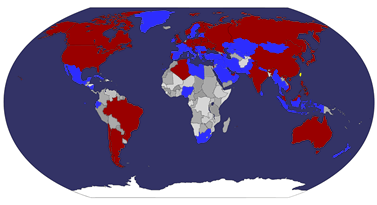Owls (Order Strigiformes) are known as “cat head hawks” in Chinese because their flat faces give them a catlike appearance. Most owls are nocturnal and prey on insects, small birds and mammals. Currently, there are 12 species of owls in Taiwan, all of which are listed as protected species. To increase public understanding and raise awareness about the issues of wildlife conservation, Chunghwa Post has planned a set of four stamps featuring owls of Taiwan. The designs follow:
1. Asio otus (TWD5): About 35 to 40 centimeters long, it has a light yellowish brown facial disc and long ear-tufts. Its upperparts are grayish white and light yellowish brown with vertical blackish brown streaks. Its belly is yellowish brown to creamy white in color, with dark brown vertical streaks and fine horizontal bars. This rarely seen migratory bird overwinters in Taiwan. It prefers thin broad-leaved and coniferous forests.
2. Otus sunia (TWD5): About 15 to 18 centimeters in length, its inconspicuous facial disc is dark brown with a touch of mottled gray. It has ear-tufts. Its upperparts are largely dark brown with fine black vertical streaks. Its foreneck and breast are light yellowish brown with subtle dark brown vertical streaks and fine horizontal bars. There are two types—one reddish and the other grayish brown. A transient bird species in Taiwan, it only occasionally winters.
3. Strix aluco (TWD10): About 35 to 40 centimeters long, its facial disc has a prominent black ring, giving its face the appearance of a halved apple. It has no ear-tuft. Its crown and hindneck are dark brown and mottled with black spots. Its underparts are yellowish brown with prominent blackish brown vertical streaks and fine horizontal bars. Mainly found in mid- to high-elevation broad-leaved or coniferous forests, it is especially fond of higher elevation coniferous forests.
4. Glaucidium brodiei (TWD25): About 15 centimeters in length, its head is small and rounded with no ear-tuft. Its upperparts are brown and its crown is a bit grayer with small white spots and larger creamy yellow spots. Its belly is white, with irregular dark brown vertical streaks along the sides. It can often be found resting in open woodlands or the forest’s edge. It is one of a few owls that are active both during the day and at night.
Beijing 2008 Paralympic Games and 2001 Summer Universiade stamps on cover
from China
-
*Jeux paralympiques de Beijing 2008 et Universiade d'été 2001 sur lettre de
Chine *
La 13ème édition des *jeux paralympiques d'été* se sont déroulés à Be...
7 hours ago








.jpg)

























 taiwan
taiwan  cover or postcard
cover or postcard  FDC
FDC 






























































































No comments:
Post a Comment